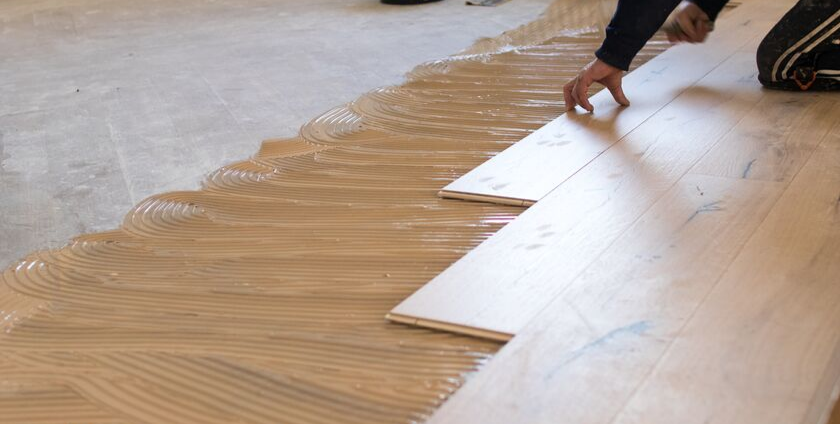What are VOCs? What is Low VOC and Why You Should Care

- Tags: air quality, CARB, Eco-friendly, EPA, formaldehyde, House Plants, off-gassing, Plants, VOCs
- Category: Blog
- 0 comment
October is National Indoor Air Quality Awareness Month, and LIFECORE is presenting a three-part series on FLOORING AND THE ENVIRONMENT and how this affects air quality.
In part 1 of our FLOORING AND THE ENVIRONMENT series, we covered the overall importance of indoor air quality and how it affects the environment both inside and outside of the home. In part 2, we delve deeper into VOCs, the main contributor to poor indoor air quality, and what you can do to lower VOC levels in your home.
What are VOCs?
VOCs are Volatile Organic Compounds that exhibit high vapor pressure at ordinary room temperature. This allows them to emit chemical particles into the air through vapors or gases, in what is also referred to as “off-gassing.” While we might expect garage-stored items like turpentine and varnishes to create off-gassing, the real surprise comes from the items inside the home that also release significant levels VOCs into the air. Anything comprised of synthetics or treated with coatings, glue, adhesives, sealants, and finishes (such as countertops, furniture, electronic devices, paint, mattresses, carpeting, etc.) can be big contributors to off-gassing. Even smaller items like household cleaners play a part.
When all of these items coexist in the same space, the level of off-gassing increases exponentially. One of the most common VOCs is formaldehyde, an organic compound that occurs naturally in everything around us, including our own bodies. However, when fabricated into the chemical compound used in synthetic materials such as glues, sealants, paint, coatings, and plastics, it can become one of the most toxic VOCs in the home.

Why You Should You Care…
VOCs can significantly affect air quality, which in turn affects health. This is especially true for those with asthma, migraines, or breathing issues, as well as the elderly, the infirmed, and children. Depending on the levels, VOCs can cause everything from eye, nose and throat irritation, to nausea and even more serious illnesses and cancer. As mentioned in part 1 of this series, off-gassing also affects the environment outside the home by adding to a ground-level ozone.
What You Can Do About It…
There are several ways to keep VOC levels low in your home or office without greatly affecting your lifestyle or budget. Start by turning off computers, printers, cell phones, and other electronics when not in use, as they can off-gas. Whenever possible, open windows and circulate fresh air and use exhaust fans in the kitchen and bathrooms to help pull pollutants out of the air. Using a dehumidifier to keep humidity below 45% can also help limit emissions, as off-gassing occurs at a higher rate when humidity is high.
Toss some of the smaller items in your home that contribute VOC levels, since no change is too small to make a difference. Switch out plastic shower curtain for a cloth one. Use stainless, ceramic or glass cookware instead of non-stick pans. Use reusable filters instead of plastic k-cups, and try organic alternatives to dryer sheets (like vinegar on a clean washcloth or baking soda added to the wash cycle). Then, going forward, purchase only environmentally safe air fresheners, hair care, and cleaning products to stay on track. Chemically-coated draperies and plastic blinds can also contribute to poor air quality, and switching to organic fabrics and materials that are not sealed with chemicals can make an impact. Lastly, fill your home with air-filtering houseplants as they can add life to a room in more ways than one.
To make the most impact, you may want to consider switching out some of the larger items in your home that are the worst offenders. Since budgets are a concern for everyone, you can make these changes over time. However, keep in mind that some of these will enhance the value of your home, so this investment in your home can pay off.
Here are some suggestions:
- Carpeting, vinyl, laminate, and many hardwood floors brands contain formaldehyde and other chemicals via the glues, coatings and finishes used. When the time comes time for new flooring, consider an engineered hardwood floor by LIFECORE. We use our ZERO-ADD technology, which eliminates the use of formaldehyde in any part of the manufacturing process. That means flooring that has VOC safety levels well below even the strictest CARB (California Air Resource Board) and EPA (Environmental Protection Agency) regulations, without compromising performance, durability, or design.
- Studies have revealed that mattresses made with petroleum-based chemicals, toxic foams, synthetic fabrics, fire retardant barriers or chemicals can release VOCs, especially when their temperature is elevated through body heat. Expensive as this can be, consider switching out children’s mattresses at the very least for brands that advertise as organic and VOC-free.
- Thinking about updating the color of the walls in your home? If your current paint job is more than five years old, you can paint over it with a low VOC paint. If it’s newer, you’ll want to remove the old paint before applying the eco-friendly version. Either way, it will make a difference since traditional paint can release VOCs for years.
- Both fabric and particle board/plywood furniture can be coated with substances that contribute to off-gassing. The good news is that there are non-toxic alternatives available on the market like couches and chairs with organic fillers and without chemical treatments for stains. Tables and chairs made of solid, untreated wood or metals can be a stylish and healthy replacement for particle board or plywood.
- Budget permitting, look into replacing your Formica, laminate or other glued/synthetic countertop with one made of a more eco-friendly material like stone, marble, soapstone, concrete, recycled glass, tile, stainless steel, or a solid surfacing like Corian.
In our third and final blog in this series “Sustainable, Eco-Friendly, Responsibly- Forested…What Does it All Mean?” we will decipher much of the confusion surrounding these terms and the various certifications as they apply to flooring.
Leave a Reply
